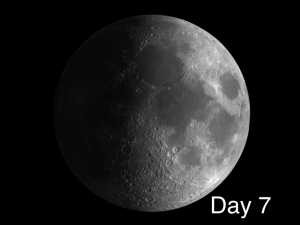 The week of February 11-17 takes us from Day 6 through Day 12. This week we will highlight the feature informally known as the Lunar X.
The week of February 11-17 takes us from Day 6 through Day 12. This week we will highlight the feature informally known as the Lunar X.
 Lunar X: [SE/M10] Around 6 days 22 hours (depending on libration – you have to get this pretty exact, it’s a narrow window) as the terminator crosses Blanchinus, the sun will light up the mountain peaks immediately to the west of the crater and you will see a brilliantly lit “X” at the intersection of the rims of Blanchinus, La Caille, and Purbach. Look for it when the terminator is around 1°-2° east, as will be the case on Monday evening. Once it has formed, the image will last only for about three hours. The formation is also known as the Purbach Cross and the Werner X. (Because it is not an officially recognized object, you will not find it listed on the Field Map. I am indebted to Dana Thompson for permission to use his photo of the Lunar X.)
Lunar X: [SE/M10] Around 6 days 22 hours (depending on libration – you have to get this pretty exact, it’s a narrow window) as the terminator crosses Blanchinus, the sun will light up the mountain peaks immediately to the west of the crater and you will see a brilliantly lit “X” at the intersection of the rims of Blanchinus, La Caille, and Purbach. Look for it when the terminator is around 1°-2° east, as will be the case on Monday evening. Once it has formed, the image will last only for about three hours. The formation is also known as the Purbach Cross and the Werner X. (Because it is not an officially recognized object, you will not find it listed on the Field Map. I am indebted to Dana Thompson for permission to use his photo of the Lunar X.)
OF ADDITIONAL INTEREST IN SPACE – MARS AND URANUS
On Monday evening, Mars and Uranus will be only 1° apart in Pisces and can be seen in the same field of a low power telescope.
======================
It is highly recommended that you get a copy of Sky and Telescope’s Field Map of the Moon, the very finest Moon map available for use at the telescope. It is available for $10.95 at www.skyandtelescope.com and on Amazon. All features mentioned in this blog will be keyed to the grid on the Field Map and will look like this: Plato: [NW/D9]
Credits:
Courtesy of Gray Photography of Corpus Christi, Texas
Lunar photos: NASA / USGS / BMDO / LROC / ASU / DLR / LOLA / Moon Globe. Used by permission
- Rupes Cauchy: A Best Known Fault on the Moon - July 22, 2024
- Moon Crater Schickard – Crater Floor has Stripes - July 15, 2024
- Moon Craters Langrenus and Vandelinus - July 8, 2024